This is a revised copy of the original document, An Introduction to Production, Marketing, and Economics of Growing Chestnuts in the South East United Sates, by R. D. Wallace and P. J. VanBlockland. 1989. UF/IFAS Department of Food Resource Economics. Staff report. #354
Introduction
Chestnuts (Castanea sp.) are represented by several species of trees in the beech family (Fagaceae). The chestnut is native to warm, temperate areas the Northern Hemisphere.
The United States is one of the few nations in the world that can grow chestnuts and does not have a significant commercial chestnut industry. Because the United States has such a small (less than 1 percent of world production) chestnut industry, chestnuts are imported to the United States in quantities with total annual value exceeding $20 million.
Development of new chestnuts cultivars, advances in propagation, and cultural techniques now allow for expansion of the commercial chestnut industry in the United States. Chestnuts may make a viable alternative crop for small farmers in Florida who are looking to diversify their operations.
History
Few tree crops have as much historical importance as a food source throughout the world as do chestnuts. Chestnuts were one of the earliest tree crops to be domesticated and were even mentioned in Chinese poetry more than 5000 years ago. The European settlers of North America found the New World was virtually one solid chestnut forest. The American chestnut was once among the most common trees in the eastern forest, from Maine to Georgia and west to the Mississippi.
This amazingly useful tree offers rot-resistant lumber, which was used for several items, from fence posts to furniture. The chestnut tree was also a source of tannin, in addition to its beautiful crop of nuts. But the accidental introduction of the chestnut blight (Cryphonectria parasitica) from the Orient in 1904 killed almost every American chestnut in the United States in less than 40 years. The loss of the chestnut in the United States is considered one of the greatest botanical disasters in Western history.
The chestnut industry is highly developed in Europe and in the Orient. The Republic of Korea and China are the top two countries for chestnut production; together these countries produce more than 40 percent of the world's chestnuts. Other major chestnut-producing countries include Italy, Turkey, Bolivia, Japan, Spain, and Portugal. The primary exporters of chestnuts to the United States are Italy, China, and The Republic of Korea.
Chestnut imports to the United States increased from 4,500 metric tons in 2003 to 5,400 metric tons in 2004, an increase that indicates the growing demand for chestnuts among US consumers. The annual value of chestnuts imported to the United States is more than $20 million.
The development of new American x Chinese hybrid chestnut cultivars—which are resistant to chestnut blight and produce large, sweet nuts—have helped to make possible expansion of the domestic chestnut industry in the United States, including in Florida. The new chestnut cultivars have high-quality characteristics that compete favorably with the imported nuts. However, the commercial US chestnut industry is relatively new; most growers have less than 10 years of experience. Major states for chestnut production include California, Oregon, Washington, Michigan, Florida, Ohio, and Virginia.
Chestnut Economics
Chestnuts can be a productive and profitable orchard crop. Trees begin to bear after three to five years, and improved cultivars can, at maturity, produce from 1,000–1,500 pounds or more per acre every year. The nuts bring from $0.75–$2.50 per pound wholesale, (depending on nut size) and $2–$5 per pound retail, depending on the market.
Marketing of domestic chestnuts has been primarily through local or direct market sales methods. Some American growers advertise fresh chestnuts via the Internet at prices of more than $10 per pound in small quantities, but this price includes FedEx or UPS shipping and handling. Local, direct-to-consumer sales may be up to $4 or $5 per pound, but such prices decrease considerably in sales to brokers, wholesalers, grocery chains, and other large markets.
To move American-grown chestnuts in large quantities, prices must to be competitive with imported nuts, and quality of American production must be superior to the quality to which foreign wholesale buyers and their American customers are accustomed.
Chestnuts crops grown in the United States have the advantage of reaching American markets earlier than imported chestnuts, with better quality control, and without the costs of international shipping. However, the key to success in moving large quantities of chestnuts is through marketing, education of the consumer and distributors, and the development of relationships with knowledgeable persons in food-distribution services. Many opportunities for marketing that did not exist in the past for small growers are now available through the Internet, but targeted marketing efforts to the food industry can also be very valuable.
Chestnut Species and Hybrids
Four species of chestnuts and several of their hybrids are grown in the United States today.
-
American chestnuts (Castanea dentata) have small, sweet nuts, upright growth form, and are highly susceptible to chestnut blight.
-
The European chestnut (Catanea sativa) is also blight susceptible and can only be grown in blight-free areas. European chestnuts trees have an upright tree form, and the nuts from European chestnuts can be quite good from some cultivars. However, many of the cultivars and seedlings produce nuts that are bland or bitter in taste and difficult to peel.
-
Chinese chestnuts (Castanea mollissima) are highly blight resistant, and some cultivars produce nuts of good size and sweet taste that are also easy to peel. Chinese chestnut trees are sometimes upright in growth form, but many are low, spreading and multiple branched at the ground.
-
Japanese chestnuts (Castanea crenata) are small, spreading, blight-resistant trees that produce large, poor tasting nuts. Japanese chestnuts are mostly used for hybridization.
-
Chinkapins (several species) produce small, sweet nuts (one per burr), are often of shrubby form and are not used for commercial nut production.
The members of the genus Castanea are very closely related and interhybridize readily. Hybrids offer some of the best potential for promising commercial cultivars. In Europe, most chestnut breeding has been done with Japanese x European crosses. In Japan and Korea, the majority of the commercial production today is with Chinese x Japanese hybrid cultivars.
In the United States, some of the recently developed American x Chinese hybrids offer the combination of characteristics that make for excellent commercial cultivars for Florida (Figure 1).
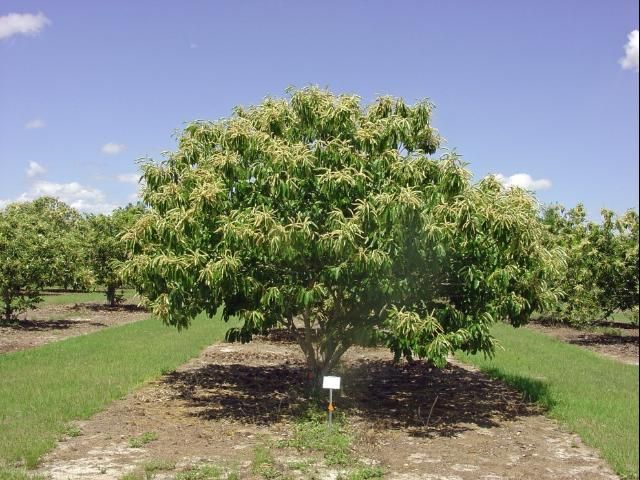
Nut Quality and Grades
Size
A primary concern in any cultivar is the size of the nuts produced. For marketing to a fresh or pre-packaged market, large size is required (Figure 2). While the US Department of Agriculture (USDA) has not adopted any standards for grades of chestnuts, the following size standards were proposed by the USDA in 2001 (Table 1).
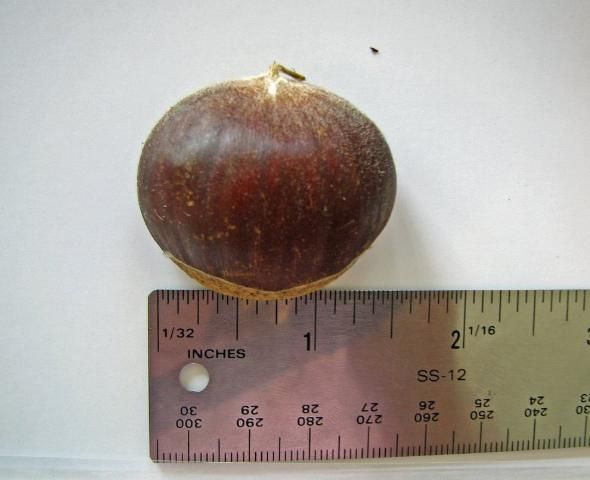
Importers have sometimes used size standards based on the number of nuts per pound (Table 2). Nuts smaller than 40 count per pound are difficult to distribute through mass marketing systems (brokers and grocery chains) because of the American desire for larger chestnut sizes (Figure 3). Smaller chestnuts are generally less desirable in the American market and bring a lower price. If, however, the chestnuts are used for drying, pureeing, flour or candies, size is not as important.
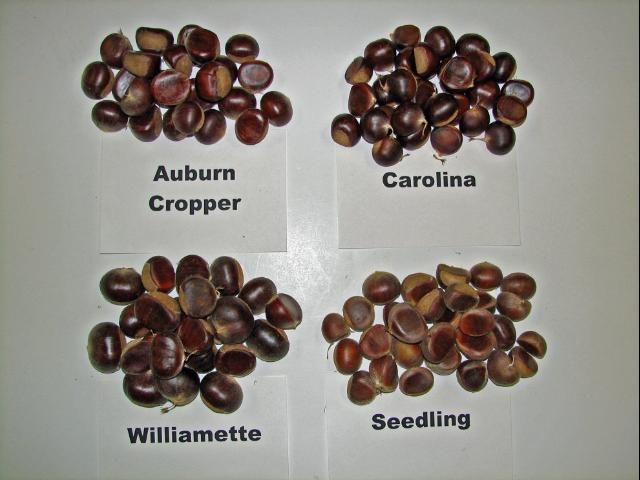
Taste
Taste is also very important. Some cultivars have a higher sugar content, even raw. The carbohydrates in chestnuts turn to sugar as the nuts mature and dry. Curing is important before cooking chestnuts, to bring out the flavor of the nuts. The American chestnut is quite sweet, as are chinkapins. Some of the Chinese chestnuts and the American hybrids have very sweet nuts. Some of the European and Chinese varieties are, by comparison, not as sweet.
Ease of Peeling
The third nut characteristic of importance is ease of peeling the nut. The pellicle or "skin" that surrounds the kernel is bitter and must be removed before eating. In some types of chestnuts, the pellicle is ingrown into the rough surface of the kernel, which makes the nuts difficult to peel and, therefore, poor eating quality. Many European chestnuts have this undesirable characteristic.
The French distinguish between types of chestnuts based on the ease of peeling. Marrons, a chestnut native to the Mediterranean, have smooth-surfaced kernels that are easy to peel, and the châtaignes having an ingrown pellicle. The marrons command a much higher price in the stores in France and in the United States than do the châtaignes, but both types of chestnut are shipped to the United States where they are popular among American consumers.
The American and Chinese chestnuts and their hybrids more frequently have smooth kernels and are easier to peel.
Ease of peeling is important in commercial processing, as well as for acceptance by the consumer; a little bit of the kernel is lost in the peeling process, and chestnuts that are easily peeled require much less time and expense to remove the pellicles.
Propagation
The predominant type of chestnut trees sold in the United States today is Chinese chestnut seedlings. Seedling Chinese chestnuts are generally variable in nut size, taste, tree form and productivity. The trees bear in 3–8 years, much later than grafted stock. The trees are, in some cases, more vigorous than grafted trees and more cold hardy. Most existing plantings of chestnuts in the United States are seedlings. Wide variability in the quality of the crop reduces the marketability of chestnuts.
Grafting and budding are the most common ways of propagation for clones of chestnuts.
Chestnuts can sometimes be affected by root stock/scion incompatibility. Factors causing this incompatibility are both ecological and genetic. Scions grafted onto rootstock with differing isoenzymes may show poor vigor, inconsistent crops, and sometimes death of the scion above the graft. Grafts fail more in very cold climates or after severe heat or drought stress.
Location and Site
Chestnuts can be grown in a wide variety of climates and environments, but the range that is suitable for growing peaches is often considered to be suitable for growing many of the chestnut cultivars. Chestnuts also grow well throughout the areas in Florida used for pecan production.
The best conditions for the production of nuts include a warm and relatively long growing season and a mild winter. Irrigation is recommended for maximum nut production and is especially important in initial orchard establishment. Though chestnuts flower late, spring frosts can damage new growing shoots, and low-lying frost pockets should be avoided.
Chestnuts prefer a well drained, upland sandy loam of pH 5.0–6.5. The soil should not be subject to standing water and/or periodic flooding. If mechanical harvesters are to be used, too much slope in the field can create difficulties in using the machinery, and wet soil conditions with autumn rains can inhibit easy movement through the orchard. North Florida is especially suited to growing chestnuts. Areas from Orlando north through the Florida Panhandle include chestnut plantings that have been growing for more than 40 years.
Orchard Planting and Production
Orchard spacing varies greatly depending upon the cultivar. However, 20x20 (108 trees/acre) is common. This spacing creates the optimum balance between close packing of the trees to increase early production of the orchard and the need to thin trees as the crowns start to touch.
Chestnuts require a well managed supply of moisture and fertilizer. Drip irrigation is recommended to conserve water and effectively provide water to the trees only, rather than to weeds in non-crop areas between rows. Fertilization programs should be based on a soil test. However, a common application for chestnut trees is 1 pound of 10-10-10 or similar analysis per year of tree age up to 15 pounds per tree applied in the spring. Fertigation, or frequent feeding through the drip system, is efficient and promotes growth with less loss of nutrients from leaching. Chestnuts are heavy feeders, and nitrogen is especially important to proper rapid growth. Like many nut trees, chestnuts are slow to start and require 2–3 years to become well established. Burrs should be removed during the first three years to promote better tree growth.
Most chestnut orchards are managed in a manner similar to pecans, with clean cultivation down the rows and sod cover crops between rows. Young chestnut orchards can be intercropped with row crops, such as perennial peanut, clover, hay or a small fruit crop until chestnut harvest begins in about five years after planting.
Pruning
Chestnuts bear on the bisexual catkins (slim, cylindrical flower clusters), which are located near the base of the current years shoot growth. The new flushes of growth occur in areas of sunlight, at the tips of branches. Pruning should maximize the amount of sunlight available to a tree. Open-center trees (like a peach tree) allow sunlight into the vase-shaped middle, as well as the tops and sides. The European orchards and the Japanese and Korean orchards are pruned in this fashion. The central-leader tree—produced by a pruning system commonly used in apples, pecans and walnuts—creates a cone-shaped tree that has bearing surface all around the outside of the cone. This method is also acceptable for use with chestnuts.
Upright-form trees respond better to mechanical shaking to remove the nuts. Very spreading trees may be more difficult to shake off the nuts because the branches tend to droop and do not translate the vibration of the shaker. Evidence also suggests a smaller tree may be more desirable than those that are too tall for ease of harvesting. Pruning, along with genetic characteristics, will be important in determining final tree shape and size. Many small-tree chestnut cultivars have produced well in Florida with very little pruning.
Orchard Pest Management
Chestnuts have a few serious pests. Chestnuts blight (Cryphonectria parasitica) is largely eliminated by planting blight-resistance varieties. Only blight-resistant trees should be considered for planting in Florida. Ink disease, a phytophthora root-rot fungus, has been a problem in the southeastern United States, but can be controlled by orchard floor management, keeping the soil well drained and not subject to wet conditions, which promote infection. Ink diease has been a problem in Europe and on the Pacific Coast of the United States, in areas that have long, wet winters.
Deer and squirrels can be common wildlife pests in chestnuts. Deer fences may be necessary if deer are a local pest, and requent harvesting of the nuts may be required if squirrels or deer are problems.
The chestnut weevil (Curculio caryatryes) lays its eggs in the developing nuts, and the mature nuts have a worm growing inside at harvest, causing the nuts to become unmarketable. The weevil spends the winter on the ground under the trees as a pupa. Few pesticides are labeled for control of chestnut weevil, so sanitation practices are critical.
After the harvest is complete, collect all extra burrs, nuts, and leaf debris and destroy by burning if possible.
The oriental chestnut gall wasp (Dryocosmus kuriphilus) is a serious pest that forms a gall in the growing chestnut shoots, thus stopping nut production. Biological and chemical controls are as yet ineffective for this wasp, but some Korean varieties show resistance to the wasp. It is highly recommended to not move chestnut trees or material from areas where gall wasp infestations occur.
Pollination and Nut Formation
Chestnuts are monoecious; both male and female flowers are borne on the current season shoots of the same tree (Figure 4). Flowers emerge on the tips of the current seasons growth, after the leaves have fully expanded, and late enough to avoid any late-spring frosts (early to mid May in Florida). Chestnuts are self sterile (will not self pollinate) and, therefore, require a pollinizer. Incomplete pollination will result in only one or two nuts forming inside the burr; the remaining nuts will not fill out. Chestnuts are primarily wind pollinated although insects may also aid in pollination. Trees should be planted at a ratio of at least 8:1 cultivar to pollinizers. Grafted trees begin to bear in two to four years, and seedlings will bear in five to seven years. If seedlings are used as pollinizers, delay in the production of the grafted trees will likely occur because pollenizer trees do not flower sufficiently in the early years (the third to fifth year after planting).
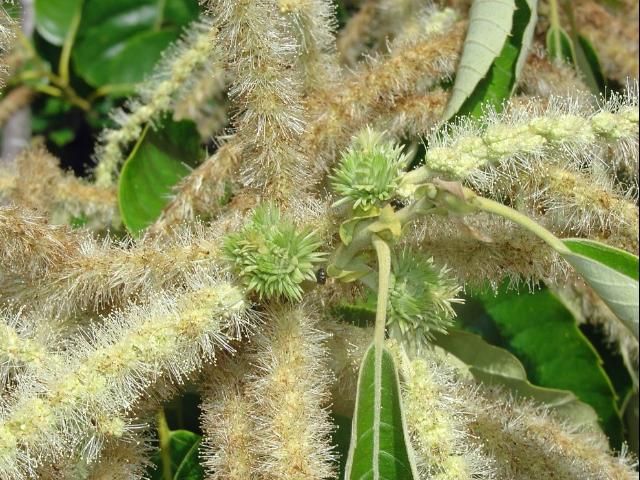
Nut development and filling out occurs primarily in the last two to three weeks before ripening (Figure 5). The nut gains the majority of its weight during this time, and since the nuts are 40 percent water and 40 percent carbohydrate, a good supply of water, either from seasonal rains or irrigation, is crucial for maximizing nut production. Time from flowering to harvest varies from 110–150 days, depending on the cultivar. As the nuts ripen, the burr begins to split open, and the nuts are released from the burr or the burr falls from the tree with the nuts still inside (Figure 6).
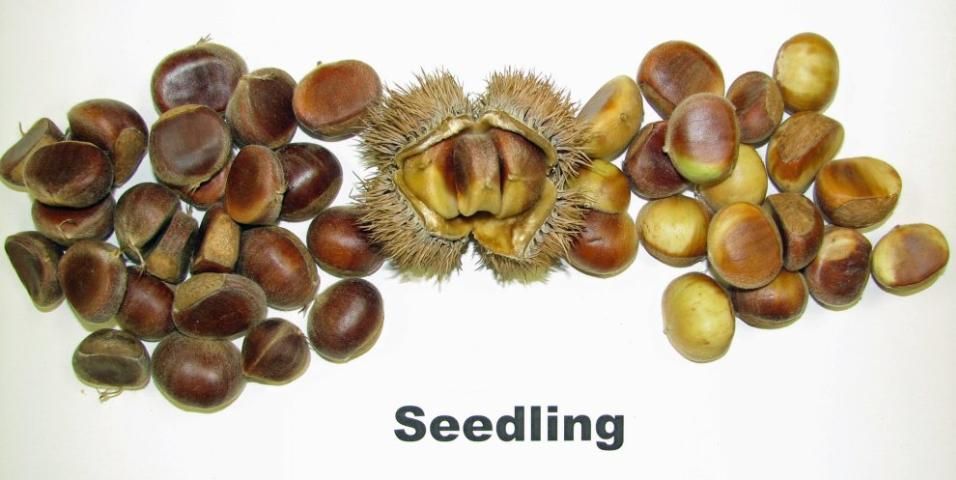
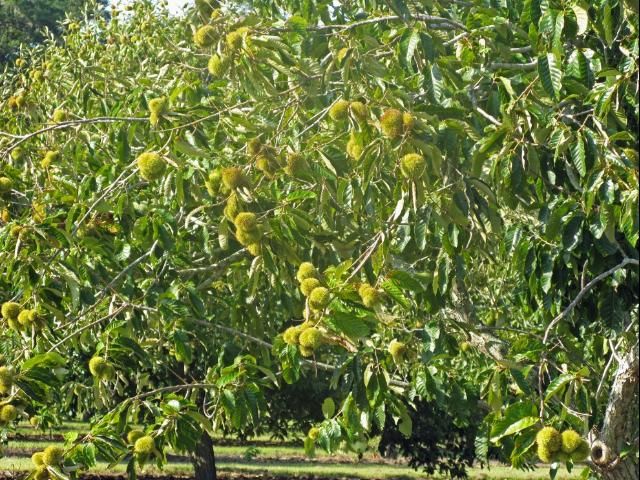
Harvesting and Storage
Harvesting of chestnuts is traditionally done with hand labor, which, in small orchards, may be more efficient than mechanical harvesting. Because chestnuts are high in carbohydrates, they decay quickly and must be harvested every two to three days to eliminate the amount of the time the nuts spend on the ground.
Mechanical harvesting of chestnuts is much the same as in the pecan, almond, or walnut industry. Shakers are successful as a means of removing the burrs from the trees. The nut and burrs can be collected, either in a catch frame or in mesh nets on the ground underneath the tree, or the nuts can be picked up with various mechanical pecan harvesters or harvesters designed for other nut crops.
Once collected from the orchard, the nuts and burrs are separated, and the nuts go directly into a cooler. The burrs are run through a deburring device, such as those used for removing the husks of walnuts, or a pecan cleaner. Green burrs with undeveloped nuts (still white) can be held separately until the nuts ripen in several days.
Nuts are washed and then graded by size and stored in tightly woven, but breathable mesh bags at 32°F and 85 percent humidity. Chestnuts will last up to six months when stored under these conditions. At warmer temperatures, the nuts will decay faster because of the higher biological activity than at lower temperatures. High humidity is required because the nuts will dehydrate and lose their quality in most coolers. A quick dip (45–60 minutes) in hot water (125°F) can kill many of the decaying organisms and the chestnut weevils larva. After the hot-water dip, the nuts are cooled in cold water and then stored at 32°F.
Processing
Whole chestnuts can be peeled and canned or frozen. This processing generally increases the shelf life of the product over the fresh nuts and, more importantly, lowers the amount of consumer labor and time in preparation. The value added to a peeled and packed product is substantial and may be important in increasing the market size of chestnuts, especially increasing the use of the nuts beyond the traditional chestnut season, Thanksgiving and Christmas. Prepackaging is a very important consideration in adapting chestnuts to the US market.
Machinery is available to mechanically peel and package chestnuts. Peeled and frozen chestnuts will retain their taste up to two years. Chestnuts can also be dried and ground into flour. In Europe and the Orient, chestnut flour has long been highly prized for its sweet taste in making breads, pastas, and pastries. Specialty chestnut products are becoming more commonly available in US markets and through Internet sales.
Marketing
The well developed distribution system used for many nuts grown in the United States is also available for chestnuts grown in this country. Growers with large, high-quality chestnuts can compete favorably with imported chestnut crops because domestic growers can reach the US market earlier and deliver a fresher product and, thus, sell at a premium price.
There are many potential markets for high-quality chestnuts grown in the United States. Gourmet and health-food markets and restaurants offer outlets where consumers are typically interested in trying and learning about new food products. Ethnic French, Italian and Oriental markets already carry chestnut products and are interested to find local, high-quality sources of chestnuts. Almost all grocery chains carry imported chestnuts at Thanksgiving and Christmas. Local community farmers markets are becoming much more popular in Florida and also serve as outlets to market nuts. Internet sales can also be a successful method to sell chestnuts and chestnut products.
Nutrition
The chestnut is a highly nutritious food. Unlike most nuts, which are high in fat (pecans and walnuts), chestnuts have only a trace of fat and one-third the calories of other nuts, such as peanuts or cashews. Chestnuts are also the only nut with a significant amount of vitamin C and no cholesterol. The protein of chestnuts is of excellent quality and comparable in amino-acid content to that of an egg. Chestnuts are considered "a grain that grows on a tree," being similar nutritionally to brown rice.
Chestnuts are delicious and can be prepared in a variety of ways, including roasted on the fire or steamed for use in soups, stews, soufflés, hors douerves, stuffings and desserts. Chestnuts may be dried and made into pasta or sweet flour for pastries and breads. Pureed or candied, chestnuts are a favorite dessert all across Europe. This diversity of uses and high nutritional quality from a perennial tree crop have made the chestnut a popular food source, including throughout history and in many different cultures around the world.
More Information
For additional documents and links regarding chestnut production and marketing, visit the fruits and nuts page of Floridas Small Farms website (http://smallfarms.ifas.ufl.edu/crops/fruits_and_nuts/nut_crops.html).